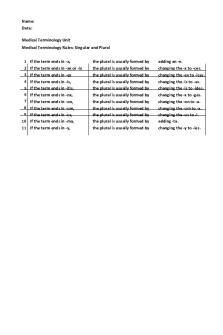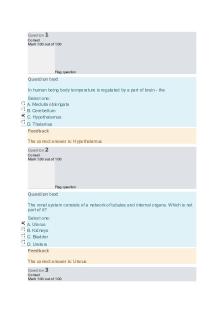Terminology Quiz 1 answers PDF

| Title | Terminology Quiz 1 answers |
|---|---|
| Course | Human Embryology |
| Institution | The University of Texas at San Antonio |
| Pages | 3 |
| File Size | 55.1 KB |
| File Type | |
| Total Downloads | 54 |
| Total Views | 141 |
Summary
This is the answers to the Teminology exercises (1-4) and Terminology Quiz 1 from Phelix Fall 2018...
Description
Terminology Quiz 1 Words and answers Compaction – This process of polarization and adhesion of blastomeres within the morula flattens their apposed cell boundaries bringing them into closer approximation to each other Cumulus expansion – within hours following an ovulatory stimulus, the cumulus cells within the follicle that will ovulate, disaggregate from each other, increasing their cell-cell separation, and then secrete a thick hyaluronic acid-rich extracellular matrix that completely invests the oocyte Cytoplasmic maturation – cytoplasmic changes occur during the process of gametogenesis within the germ cell line of both male and female, converting the germ line stem cells into mature gametes Definitive oocyte or definitive spermatocyte (spermatid) - the definitive spermatocyte and oocyte have completed both meiotic divisions Embryonic stem cells – these cells arise from the inner cell mass during in vitro culture of blastocysts removed from the genital tract of a pregnant animal th
Genital ridge – the germ cells become amoeboid and migrate to the future 10 thoracic level of the embryo where they induce development of the genital ridges, just medial to the mesonephroi th
(embryonic kidneys) at about the future 10 thoracic level GIFT - the gamete intrafollopian transfer technique is often used in cases where the mother may suffer from anovulatory syndrome or where the father's spermatozoa may be relatively immotile Inner cell mast (embryoblast) - it is thought that blastomeres arising from the first cells to divide during early cleavages may be preferentially segregated toward the center of the multicellular morula where they continue to differentiate from the blastomeres at the periphery Allantois – This ventral diverticulum of the hindgut becomes a superior extension of the primitive urogenital sinus (and eventually the bladder) after partitioning of the cloaca Amnion – this term refers to the membrane around the amniotic cavity and is synonymous with "amniotic sac" Chorion – this term refers to the outermost fetal membrane that surrounds the chorionic cavity Cytotrophoblast – the trophoblast begins to proliferate at the embryonic pole of the blastocyst at the nd
beginning of the 2 week to form the invasive synctiotrophoblast Epiblast - this sheet of cells appears with the adjacent hypoblast as the embryoblast differentiates at the end of the first week to form the bilaminar embryo Exocoelomic membrane – cells that constitute the exocoelomic membrane are formed as cells at the periphery of the hypoblast proliferate and migrate onto the inner surface of the cytotrophoblast cells lining the blastocyst cavity Hypoblast - the hypoblast is formed at the beginning of the first week along with the epiblast Syncytiotrophoblast – this highly invasive syncytium is produced by mitoses within cells of the cytotrophoblast at the embryonic pole of the blastocyst on about day 6 Trophoblast – the trophoblast arises from the outer cell mass that first begins to differentiate during the morula stage of development Yolk sac – the primary yolk sac (primitive yolk sac or exocoelomic cavity) is formed by transformation of the blastocyst cavity as extraembryonic endoderm (also called Heuser's membrane or the exocoelomic membrane) migrates out from the edge of the hypoblast to form an inner lining of the cytrophoblast Brain vesicles – the primary brain vesicles, the prosencephalon (forebrain), mesencephalon (midbrain),
and rhombencephalon (hindbrain) do not form until complete closure of the cranial neuropore but expansions of the neural plate that form each vesicle are apparent within the neural plate Buccopharyngeal membrane – this region of fusion of epiblast and hypoblast is apparently early in the third week Cloacal membrane – the cloacal membrane represents the caudal end of the hindgut and will form the inferior boundary of the urinary system and the gastrointestinal tract as it is divided into an anterior th
urogenital membrane and posterior anal membrane in the 7 week Ectoderm – the ectoderm descends from epiblast cell that remain following completion of gastrulation Gastrulation - this process of epiblast ingress through the primitive streak forms the primary germ layers; namely the definitive endoderm and mesoderm Neurenteric canal - during development of the notochord, the ventral floor of the hollow notochordal process degenerates allowing communication (the neurenteric canal) between the amniotic cavity and the yolk sac through the primitive pit Notochordal process – the notochordal process is one of the first mesodermal structures to arise by gastrulation as cells surrounding the primitive pit form a hollow tube that extends cranially in the axial midline Primitive groove – this shallow groove runs from the primitive pit to the caudal end of the primitive streak Primitive node – this lip of ectoderm around the primitive pit at the cranial end of the primitive streak forms the notochordal process Somitomere – prior to segmentation of paraxial mesoderm into somites, the paraxial mesodermal organizes segmental whorls called somitomeres Anencephaly - failure of the cranial neuropore to close may result in maldevelopment of the neural epithelium of the brain and its exposure at the forehead or crown caudal neuropore - initial formation of the neural tube leaves two large openings, one a cranial neuropore, and the other, a caudal neuropore Dermatome - the dermamyotome splits into a dorsolateral dermatome and a inferoventral myotome dorsal primary ramus – the dorsal branch of any spinal nerve which innervates skin and deep muscles of the back Epimere – myotomes at every segment separate into an epimere and a hypomere Glioblast - after producing neuroblasts, the ventricular neuroectoderm of the neural tube produces glioblasts that will form supporting cells of the central nervous system mantle layer - differentiating neuroblasts and glioblasts of the neural tube form a layer of gray matter peripheral to the ventricular layer which become the alar and basal columns marginal layer - this most peripheral layer of white matter of the developing neural tube is comprised of the nerve cell fibers that emanate from the neuronal cell bodies of the mantle layer Myotome - the dermamyotome splits into a dorsolateral dermatome and a ventromedial myotome neural crest - these cells arise from the lateral lips of the neural folds from the most caudal part of the diencephalon to the caudal end of the neural tube Neurulation - neurulation is the process of folding of the neural plate and closure of the cranial and caudal neuropores to form the neural tube
Rachischisis - this term is derived from the Greek and thus is a synonym for spina bifida Sclerotome - the somites split into a sclerotome and a dermamyotome sulcus limitans - this narrow groove running longitudinally along the inner surface of the lateral wall of the neural tube divides the dorsal (alar) columns from the ventral (basal) columns ventricular layer – this layer of neuroepithelium is located adjacent to the neural canal...
Similar Free PDFs

Terminology Quiz 1 answers
- 3 Pages

Medical Terminology Quiz 1 student
- 12 Pages

Medical Terminology-Plurals Quiz
- 3 Pages

HRM 200 Quiz 1 - Quiz 1 Answers
- 11 Pages

Quiz 1 questions + answers
- 4 Pages

Quiz 1, answers
- 6 Pages

QUIZ#1 KEY Answers
- 3 Pages

Module 1 Quiz answers
- 5 Pages

Module 1 Quiz Answers
- 1 Pages

Chapter 1 Quiz answers
- 7 Pages

Chapter 1 Quiz & Answers
- 4 Pages

Quiz 1 answers
- 5 Pages

Possible quiz 1 answers
- 2 Pages

Quiz 1 2017, answers
- 35 Pages
Popular Institutions
- Tinajero National High School - Annex
- Politeknik Caltex Riau
- Yokohama City University
- SGT University
- University of Al-Qadisiyah
- Divine Word College of Vigan
- Techniek College Rotterdam
- Universidade de Santiago
- Universiti Teknologi MARA Cawangan Johor Kampus Pasir Gudang
- Poltekkes Kemenkes Yogyakarta
- Baguio City National High School
- Colegio san marcos
- preparatoria uno
- Centro de Bachillerato Tecnológico Industrial y de Servicios No. 107
- Dalian Maritime University
- Quang Trung Secondary School
- Colegio Tecnológico en Informática
- Corporación Regional de Educación Superior
- Grupo CEDVA
- Dar Al Uloom University
- Centro de Estudios Preuniversitarios de la Universidad Nacional de Ingeniería
- 上智大学
- Aakash International School, Nuna Majara
- San Felipe Neri Catholic School
- Kang Chiao International School - New Taipei City
- Misamis Occidental National High School
- Institución Educativa Escuela Normal Juan Ladrilleros
- Kolehiyo ng Pantukan
- Batanes State College
- Instituto Continental
- Sekolah Menengah Kejuruan Kesehatan Kaltara (Tarakan)
- Colegio de La Inmaculada Concepcion - Cebu

